Difference between revisions of "G1-Group10"
| Line 33: | Line 33: | ||
International Food Chain (IFC) is a leading brand in its sector, with over 18000 outlets worldwide and an ever-growing presence in the global market. In Taiwan alone, IFC has over 240 branches and are constantly expanding. | International Food Chain (IFC) is a leading brand in its sector, with over 18000 outlets worldwide and an ever-growing presence in the global market. In Taiwan alone, IFC has over 240 branches and are constantly expanding. | ||
| − | However, as the franchise grows bigger, so does its challenges. One of the challenges involves the lack of | + | However, as the franchise grows bigger, so does its challenges. One of the challenges involves the lack of a geographical analysis to efficiently compare the performance of each chain to one another. |
Leveraging on this fact, our group aims to digitalise the data and conduct in-depth analysis on each branch. We hope to track the performance of each chain in relation to Point-Of-Interests surrounding each chain, uncovering and comprehending phenomena, with the aid of spatial data. | Leveraging on this fact, our group aims to digitalise the data and conduct in-depth analysis on each branch. We hope to track the performance of each chain in relation to Point-Of-Interests surrounding each chain, uncovering and comprehending phenomena, with the aid of spatial data. | ||
| Line 207: | Line 207: | ||
! Column !! Description !! Example | ! Column !! Description !! Example | ||
|- | |- | ||
| − | | fid|| Unique | + | | fid|| Unique ID of each Town || “K12” |
|- | |- | ||
| − | | Country|| | + | | Country|| Unique numerical ID of each town || 10005060 |
|- | |- | ||
| − | | Market|| Name of the | + | | Market|| Name of the Town in Mandarin|| “半線城” |
|- | |- | ||
| − | | PH/PHD|| | + | | PH/PHD|| Name of the Town in English|| “Bamboo Town” |
|- | |- | ||
| − | | Status|| | + | | Status|| Unique ID of each County|| “U” |
|- | |- | ||
| − | | Milestone|| | + | | Milestone|| Unique numerical ID of each County|| 10015 |
|- | |- | ||
| − | | Local Code|| | + | | Local Code|| Name of the County in Mandarin|| “台北市” |
|- | |- | ||
| − | | CHAMPS Code|| | + | | CHAMPS Code|| Name of the Town in English|| “Bamboo Town” |
|- | |- | ||
| − | | JDE Code|| | + | | JDE Code|| Unique ID of each County|| “U” |
|- | |- | ||
| − | | Store Name|| | + | | Store Name|| Unique numerical ID of each County|| 10015 |
|- | |- | ||
| − | | Latest Asset Type|| | + | | Latest Asset Type|| Name of the County in Mandarin|| “台北市” |
|- | |- | ||
| − | | Facility Type|| | + | | Facility Type|| Name of the Town in English|| “Bamboo Town” |
|- | |- | ||
| − | | City Location|| | + | | City Location|| Unique ID of each County|| “U” |
|- | |- | ||
| − | | Location Type|| | + | | Location Type|| Unique numerical ID of each County|| 10015 |
|- | |- | ||
| − | | Open Date|| | + | | Open Date|| Name of the County in Mandarin|| “台北市” |
|- | |- | ||
| − | | Close Date|| | + | | Close Date|| Unique numerical ID of each County|| 10015 |
|- | |- | ||
| − | | Corresponding Relo-Open / Relo-Closure Store Name|| | + | | Corresponding Relo-Open / Relo-Closure Store Name|| Name of the County in Mandarin|| “台北市” |
|- | |- | ||
| − | | Corresponding Relo-Open / Relo-Closure Date|| | + | | Corresponding Relo-Open / Relo-Closure Date|| Unique numerical ID of each County|| 10015 |
|- | |- | ||
| − | | Corresponding Relo-Open / Relo-Closure Asset Type|| | + | | Corresponding Relo-Open / Relo-Closure Asset Type|| Name of the County in Mandarin|| “台北市” |
|- | |- | ||
| Store Address|| Address of the store|| B1 & 1F., No. 52-1, Hsin Sheng S. Rd., Sec. 1, Taipei, Taiwan (R.O.C) | | Store Address|| Address of the store|| B1 & 1F., No. 52-1, Hsin Sheng S. Rd., Sec. 1, Taipei, Taiwan (R.O.C) | ||
Revision as of 00:36, 22 November 2019
Contents
Introduction
International Food Chain (IFC) is a leading brand in its sector, with over 18000 outlets worldwide and an ever-growing presence in the global market. In Taiwan alone, IFC has over 240 branches and are constantly expanding.
However, as the franchise grows bigger, so does its challenges. One of the challenges involves the lack of a geographical analysis to efficiently compare the performance of each chain to one another.
Leveraging on this fact, our group aims to digitalise the data and conduct in-depth analysis on each branch. We hope to track the performance of each chain in relation to Point-Of-Interests surrounding each chain, uncovering and comprehending phenomena, with the aid of spatial data.
Problem and Motivation
To provide an analysis that allows for:
- Digitizing of each chain’s trade and delivery area
- Business profiling of the company’s outlet to determine Points-Of-Interests (POIs) that can generate insights such as: Highest earning outlets, relative performance of outlets, outlet’s profile patterns and item sales information.
- Allow for informed business decisions, such as determining locations for new outlet openings with matching POIs of high sales outlets
- Scalable program to incorporate future data to generate current information (Using data from other cities besides Taiwan)
- Easy and intuitive tool to quickly view information with regards to all branches
Objectives
This project aims to provide insights into the following:
- Missing Areas in trade zone
- Number of POIs surrounding each store
- Store performance with regards to sales
- Delivery Information
- Population Density
- Buffer and proximity
- Nearest Competitors to store
- Variable importance based on regression analysis
Background Survey of Related Works (WIP)
| Visualizations | Explaination |
|---|---|
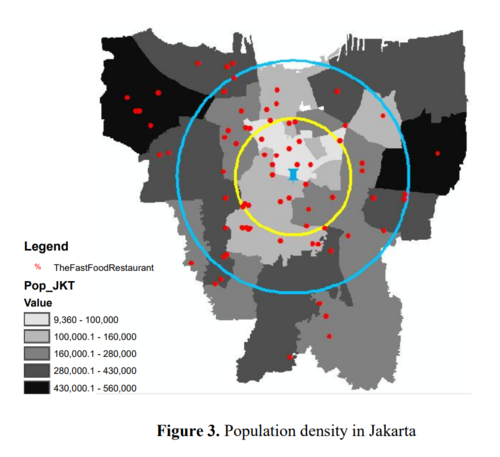
|
The visualization provides the buffer polygons, as well as representing population density of the area through colour. By comparing the two, we can conclude whether the center of activity is proportional to the population density in a region. It allows us to perform further exploration to see what spatial information significantly affects the level of activity in a city, such as the availability of points-of-interest. This visualization is great as it allows the viewer to clearly see multiple dimensions dealing with spatial data in an elegant way. |
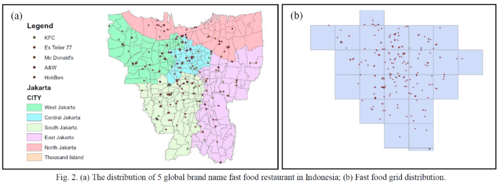
|
Data source: https://www.researchgate.net/publication/324949619_Visualization_of_Fast_Food_Restaurant_Location_using_Geographical_Information_System |
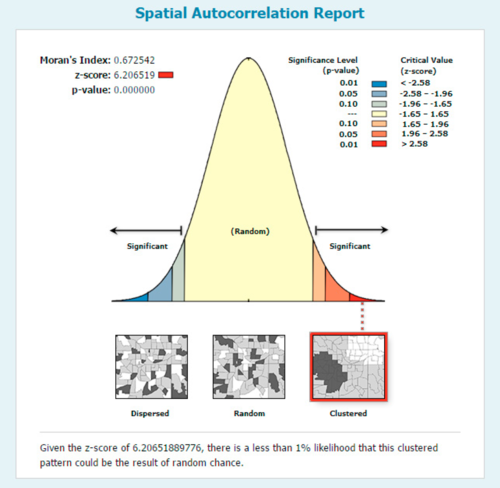
|
Data source: https://www.researchgate.net/publication/324949619_Visualization_of_Fast_Food_Restaurant_Location_using_Geographical_Information_System |
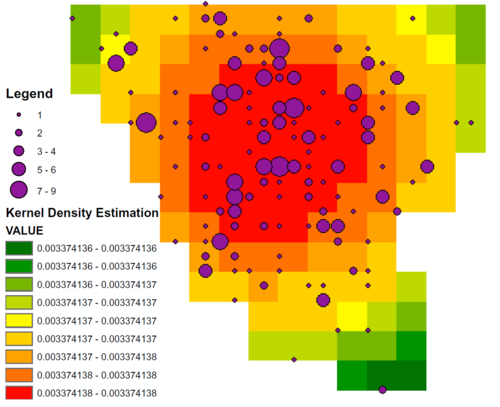
|
Data source: https://www.researchgate.net/publication/324949619_Visualization_of_Fast_Food_Restaurant_Location_using_Geographical_Information_System |
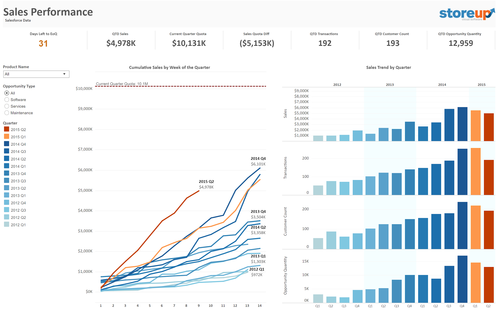
|
Data source:
https://public.tableau.com/profile/mirandali#!/vizhome/Salesforce-SalesPerformance/SalesPerformance This databoard shows the cumulative sales. We could learn from this and display by outlets to compare the performance by having multiple forms of visualization. We really like the fact that certain key summarizations and variables are displayed on the top, and will consider using this in our project. |
Tools and Libraries
The following tools and libraries are used in the digitisation and analysis:
- QGIS
- Python
- R
- Tableau
Datasets
Datasets Provided:
| Dataset | Rationale | ||||||||||||||||||||||||||||||||||||||||||||||||||||||||||||||||||||||||||||||||||||
|---|---|---|---|---|---|---|---|---|---|---|---|---|---|---|---|---|---|---|---|---|---|---|---|---|---|---|---|---|---|---|---|---|---|---|---|---|---|---|---|---|---|---|---|---|---|---|---|---|---|---|---|---|---|---|---|---|---|---|---|---|---|---|---|---|---|---|---|---|---|---|---|---|---|---|---|---|---|---|---|---|---|---|---|---|---|
| |||||||||||||||||||||||||||||||||||||||||||||||||||||||||||||||||||||||||||||||||||||
| |||||||||||||||||||||||||||||||||||||||||||||||||||||||||||||||||||||||||||||||||||||
| |||||||||||||||||||||||||||||||||||||||||||||||||||||||||||||||||||||||||||||||||||||
| |||||||||||||||||||||||||||||||||||||||||||||||||||||||||||||||||||||||||||||||||||||
|
Foreseen Technical Challenges
We encountered the following technical challenges throughout the course of the project. We have indicated our proposed solutions, and the outcomes of the solutions.
| Key Technical Challenges | Proposed Solution | Outcome |
|---|---|---|
|
NA | |
|
We managed to start using the languages quickly and suit our own project needs. Each of us work on different parts such as setting up, designing, logic and deployment. This speeds up our project progress. | |
|
The adopted process was having clear instructions issued to each member in the team, along with maintaining constant communication with each other. In the event that the dataset is deemed too dirty to be usable, it was dropped along with sourcing for new data that would be a suitable replacement. | |
|
NA | |
|
The data points can better allow us to generate insights on the profile of each outlet via its trade area. | |
|
NA |
Roles & Milestones (WIP)
- Roles
| Kelvin Chia Sen Wei | Linus Cheng Xin Wei | Eugene Choy Wen Jie |
|---|---|---|
Wiki Writer |
Report Writer |
Data Cleaner 2 |
- Project Timeline
References
- Project Page: https://wiki.smu.edu.sg/1920t1smt201/GIS_Project
- Python Pandas: https://pandas.pydata.org/
- Tableau: https://www.tableau.com/learn/training
- QGIS: http://www.qgistutorials.com/en/
Comments
Feel free to leave comments / suggestions!

